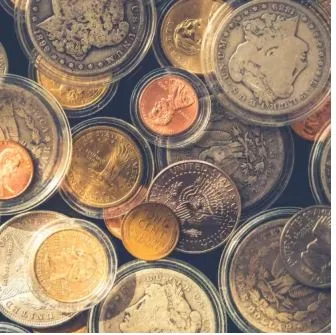Why Americans Are Turning to Physical Gold and Silver Amid Economic Uncertainty
Economic uncertainty has Americans reconsidering their financial strategies. Recent Federal Reserve data shows household gold holdings increased 15% since 2022, while silver purchases reached decade-high levels. This shift toward physical precious metals reflects growing concerns about inflation, banking stability, and currency devaluation.
The Numbers Behind the Trend
The U.S. Mint reported selling 817,500 American Gold Eagles in 2023, up from 634,500 in 2022. Silver Eagle sales topped 24.7 million ounces last year, according to official Mint statistics. These figures represent actual physical metal leaving vaults and entering private hands.
Central banks joined this buying spree. The World Gold Council reports central banks purchased 1,037 metric tons of gold in 2023, the second-highest annual total on record. China’s central bank added gold for 17 consecutive months through May 2024.
Local dealers across America confirm this trend. Operations like Waco Coin Buyers report steady increases in both buyers seeking metals and sellers looking to liquidate portions of their holdings at current high prices.
Understanding the Economic Drivers
Several factors push Americans toward precious metals. Let’s break down each one.
Inflation concerns persist. The Bureau of Labor Statistics shows cumulative inflation exceeded 20% since 2020. A dollar today buys what 80 cents bought four years ago. Gold prices rose 62% during the same period, outpacing inflation.
Banking worries linger. The 2023 failures of Silicon Valley Bank, Signature Bank, and First Republic Bank reminded Americans that bank deposits carry risks. FDIC insurance covers only $250,000 per depositor per bank. Physical metals need no institutional intermediary.
Currency devaluation fears grow. The Federal Reserve’s balance sheet expanded from $4.2 trillion in 2020 to nearly $8 trillion at its peak. This money printing raises questions about long-term dollar strength. Gold maintains purchasing power across centuries while fiat currencies average 27-year lifespans, according to a study by JPMorgan.
Geopolitical tensions increase. Trade disputes, sanctions, and military conflicts create economic uncertainty. The Treasury Department reports foreign holdings of U.S. debt declined for three straight quarters. Countries reducing dollar reserves often increase gold holdings instead.
How Precious Metals Protect Wealth
Gold and silver serve different protective functions in portfolios. Here’s what each metal offers.
Gold acts as insurance. Gold typically rises when stocks fall. During the 2008 financial crisis, the S&P 500 dropped 37% while gold gained 25%. This negative correlation makes gold a portfolio stabilizer.
Silver provides industrial exposure. Silver consumption in solar panels, electronics, and medical devices creates industrial demand beyond investment interest. The Silver Institute projects industrial demand will exceed 630 million ounces in 2024, representing 60% of total demand.
Both metals hedge currency risk. Precious metals maintain value across currencies. When the dollar weakens against other currencies, gold and silver prices typically rise in dollar terms, preserving purchasing power.
The Practical Side of Metal Ownership
Buying physical metals requires different considerations than purchasing stocks or bonds. New buyers should understand these practical aspects.
Storage matters. Home safes, bank safety deposit boxes, and private vaulting services each offer different security levels and costs. Insurance for home storage typically requires specific riders on homeowners policies.
Liquidity varies. Common coins like American Eagles and Canadian Maple Leafs sell quickly at any dealer. Rare numismatic coins may take longer to sell and require specialized buyers. Generic rounds and bars fall between these extremes.
Premiums fluctuate. Physical metal costs more than spot price due to minting, distribution, and dealer margins. These premiums range from 3% for large gold bars to 30% for fractional silver coins during high-demand periods.
Authentication prevents losses. Counterfeit metals circulate in markets. Reputable dealers use electronic testers, ultrasonic devices, and other technologies to verify authenticity. Buying from established dealers reduces counterfeit risks.
Tax Implications Few Discuss
The IRS classifies precious metals as collectibles, taxing gains at 28% rather than the 15-20% capital gains rate for stocks held over one year. This higher rate surprises many sellers.
State sales taxes vary widely. Texas exempts precious metals from sales tax entirely. California charges sales tax on purchases under $2,000. Some states tax coins but not bars. Buyers should research local regulations.
Reporting requirements exist for large transactions. Dealers must report cash purchases over $10,000 to the Treasury Department via Form 8300. Certain sales trigger 1099-B reporting, including sales of 25 or more Gold Eagles or 1,000 or more Silver Eagles.
Regional Market Differences
Precious metals markets vary significantly by region. Urban areas typically offer more dealers and competitive pricing. Rural areas may have limited options but sometimes feature better relationships between dealers and customers.
Texas stands out as particularly friendly to precious metals investors. The state maintains its own gold depository, exempts metals from sales tax, and has proposed legislation to make gold and silver legal tender. Local dealers benefit from this supportive environment.
Coastal states often charge higher premiums due to increased operational costs and regulations. Midwest markets typically offer moderate pricing with steady availability. Southern states show strong demand for silver, while Western states prefer gold.
Warning Signs to Recognize
Not every precious metals opportunity deserves consideration. Buyers should watch for these red flags.
Pressure tactics signal problems. Legitimate dealers let customers decide at their own pace. High-pressure sales techniques often accompany overpriced products.
Excessive premiums indicate markup. While premiums vary, anything over 10% for gold or 35% for silver warrants scrutiny. Commemorative coins and “special editions” often carry unjustified markups.
Storage schemes raise questions. Companies offering to store metals you never see may run fractional reserve systems or outright scams. Physical possession eliminates these risks.
Confiscation stories mislead. Some sellers claim certain coins avoid government confiscation. Executive Order 6102 in 1933 had exemptions, but no current law distinguishes between coin types for confiscation purposes.
Building a Metals Strategy
Financial advisors typically recommend 5-10% portfolio allocation to precious metals. This percentage provides protection without overexposure. Individual circumstances determine optimal allocations.
Dollar-cost averaging works for metals like stocks. Regular monthly purchases smooth price volatility. Buying fixed dollar amounts rather than fixed ounces automatically purchases more metal when prices drop.
Diversification within metals makes sense. Combining gold and silver balances stability with growth potential. Adding platinum or palladium introduces different market dynamics. Mixing coins, rounds, and bars provides liquidity options.
The Local Dealer Advantage
Online dealers offer convenience and selection. Local dealers provide immediate possession and personal service. Each channel serves different needs.
Local dealers eliminate shipping risks and delays. Buyers receive metals immediately without delivery concerns. Sellers get paid instantly rather than waiting for mail and verification.
Relationships with local dealers create opportunities. Dealers often contact regular customers when unusual items arrive or prices reach specified levels. These relationships build trust over multiple transactions.
Face-to-face transactions allow thorough inspection before purchase. Buyers can examine exact items rather than representative photos. This transparency reduces disputes and returns.
What History Teaches
Previous economic disruptions offer lessons about precious metals performance. The 1970s stagflation period saw gold rise from $35 to $850 per ounce. The 2008 financial crisis pushed gold from $700 to $1,900.
Not every crisis benefits metals equally. The COVID-19 pandemic initially dropped gold prices as investors sold everything for cash. Prices recovered and reached record highs once immediate liquidity needs passed.
Physical premiums disconnect from paper prices during crises. March 2020 saw physical gold trade $100 above spot prices when supply chains disrupted. Similar disconnections occurred in 2008 and 2011.
Looking Forward
Several trends may affect precious metals markets in coming years. Digital currencies prompt questions about traditional stores of value. Environmental regulations could affect mining supply. Solar panel growth increases industrial silver demand.
Younger investors show different preferences than previous generations. Millennials buy more silver than gold, preferring lower entry prices. Generation Z explores cryptocurrency alternatives to traditional metals.
Technology changes how people buy and sell metals. Mobile apps enable instant price checking. Blockchain verification may reduce counterfeit risks. Online marketplaces connect buyers and sellers directly.
Americans increasingly view precious metals as financial insurance rather than speculation. This shift from trading to holding suggests sustained physical demand regardless of short-term price movements. Local markets adapt to serve these long-term holders with education, fair pricing, and reliable service.





